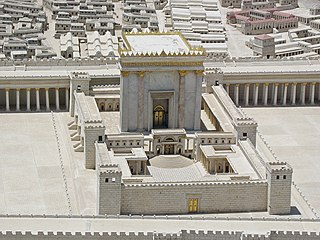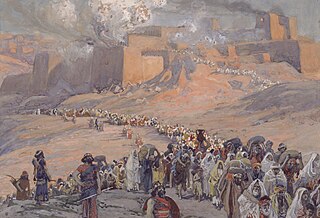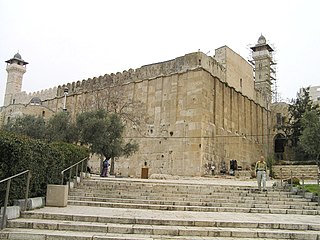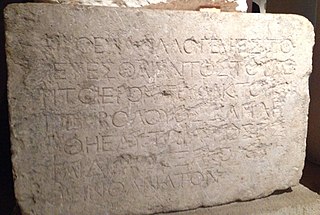 W
WThe Second Temple was the Jewish holy temple, which stood on the Temple Mount in Jerusalem, between c. 516 BCE and c. 70 CE, defined as the Second Temple period.
 W
WThe Babylonian captivity or Babylonian exile is the period in Jewish history during which a number of people from the ancient Kingdom of Judah were captives in Babylon, the capital of the Neo-Babylonian Empire. The event is described in the Hebrew Bible and its historicity is supported by archaeological and non-biblical evidence.
 W
WThe Finding in the Temple, also called Christ among the Doctors or the Disputation, was an episode in the early life of Jesus depicted in chapter 2 of the Gospel of Luke. It is the only event of the later childhood of Jesus mentioned in a gospel.
 W
WHerodian architecture is a style of classical architecture characteristic of the numerous building projects undertaken during the reign of Herod the Great, the Roman client king of Judea. Herod undertook many colossal building projects, most famously his reconstruction of the Temple in Jerusalem. Many of his structures were built upon comparable, previous Hasmonean buildings and most of his have, in their turn, vanished as well.
 W
WThe Holyland Model of Jerusalem, also known as Model of Jerusalem at the end of the Second Temple period is a 1:50 scale model of the city of Jerusalem in the late Second Temple period. The model was moved from its original location at the Holyland Hotel in Bayit VeGan, Jerusalem, to a new site at the Israel Museum in June 2006.
 W
WThe Magdala stone is a carved stone block unearthed by archaeologists in a Galilean synagogue in Israel, dating to before the destruction of the Second Temple in Jerusalem in the year 70.
 W
WTractate Middot is the tenth tractate of Seder Kodashim of the Mishnah and of the Talmud. This tractate describes the dimensions and the arrangement of the Temple Mount in Jerusalem, and the Second Temple buildings and courtyards, various gates, the altar of sacrifice and its surroundings, and the places where the Priests and Levites kept watch in the Temple.
 W
WThe Presentation of Jesus at the Temple is an early episode in the life of Jesus, describing His presentation at the Temple in Jerusalem, to be redeemed by the parents' sacrifice from His birth-state of sanctity, i.e. and predestined by His firstborn status to serve as a priest. The feast is celebrated by many Christian Churches on the holiday of Candlemas. It is described in chapter 2 of the Gospel of Luke in the New Testament of the Christian Bible. Within the account, "Luke's narration of the Presentation in the Temple combines the purification rite with the Jewish ceremony of the redemption of the firstborn ."
 W
WThe siege of Jerusalem in the year 70 CE was the decisive event of the First Jewish–Roman War, in which the Roman army captured the city of Jerusalem and destroyed both the city and its Temple. The Roman army, led by the future Emperor Titus, with Tiberius Julius Alexander as his second-in-command, besieged and conquered the city of Jerusalem, which had been controlled by Judean rebel factions since 66 CE, following the Jerusalem riots of 66, when the Judean provisional government was formed in Jerusalem.
 W
WSolomon's Stables is an underground vaulted space now used as a Muslim prayer hall by the name of El-Marwani Mosque, some 600 square yards in area, at the bottom of stairs which lead down from the al-Aqsa Mosque, under the Temple Mount, to the base of the southern wall of the Temple Mount in Jerusalem. Solomon's Stables are located under the southeastern corner of the Temple Mount, 12.5 m (41 ft) below the courtyard, and feature twelve rows of pillars and arches. In December 1996 the Waqf converted the area into a prayer hall by adding lights and floor tiles, and renamed it the El-Marwani Prayer Hall.
 W
WThe Temple Warning inscription, also known as the Temple Balustrade inscription or the Soreg inscription, is an inscription that hung along the balustrade outside the Sanctuary of the Second Temple in Jerusalem. Two of these tablets have been found.
 W
WThe Zealot Temple Siege was a short siege of the Temple in Jerusalem fought between Jewish factions during the First Jewish–Roman War. According to the historian Josephus, the forces of Ananus ben Ananus, one of the heads of the Judean provisional government and former High Priest of Israel, besieged the Zealots who held the Temple. When John of Giscala led the Zealots to believe that Ananus had contacted the Roman General Vespasian for assistance in retaking control of all Jerusalem, the Zealots, driven to desperation, asked the Edomites (Idumeans) for assistance in preventing the delivery of the city to the Romans. When the Edomites arrived, the Zealots opened the gates of Jerusalem to them, and the Edomites slaughtered ben Hanan's forces, killing him as well.